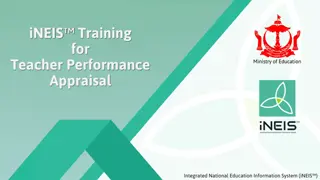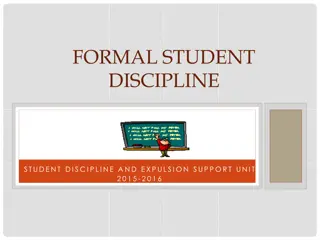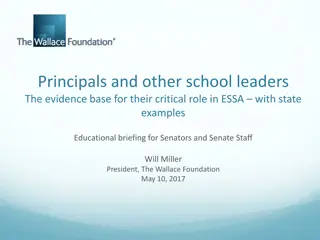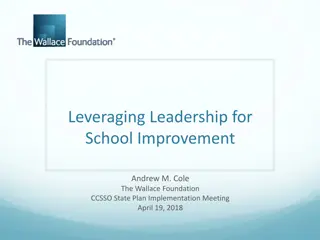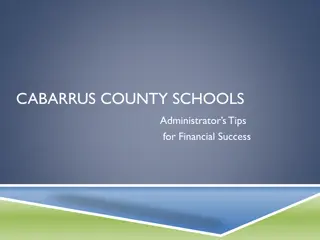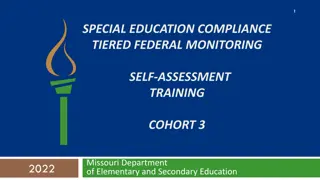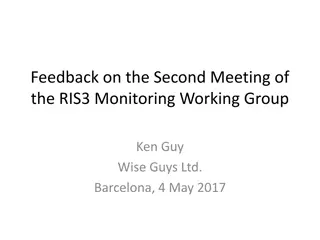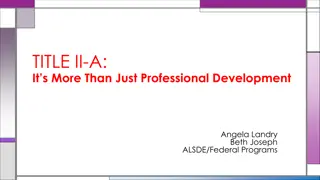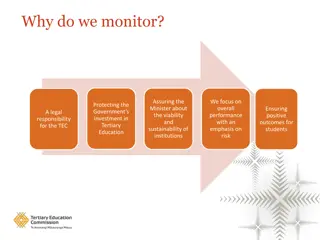Understanding Special Education Monitoring and Support for Principals
Special Education for Principals involves navigating a complex world of federal and state rules under the Individuals with Disabilities Education Act. Principals play a crucial role in monitoring and supervising special education, despite facing challenges due to lack of dual licensing. Special Education Profiles help districts assess their effectiveness in meeting the needs of students with disabilities, focusing on areas like proficiency rates, discipline, graduation rates, and more. It is essential for all students to receive high-quality instruction, highlighting the collaboration needed between general and special education teachers for better outcomes.
Download Presentation

Please find below an Image/Link to download the presentation.
The content on the website is provided AS IS for your information and personal use only. It may not be sold, licensed, or shared on other websites without obtaining consent from the author. Download presentation by click this link. If you encounter any issues during the download, it is possible that the publisher has removed the file from their server.
E N D
Presentation Transcript
Special Education for Principals
Special Education is a complex world of federal and state rules governed under the Individual with Disabilities Education Act. Monitoring and supervising special education is one of the most difficult roles of a principal due to the lack of preparation for those not dually licensed in special education and school administration. Special education is the one area of school related laws that can cause you many hours of frustration, but it s important for you to know some of the basic elements of what drives providing a free and appropriate public education to your students identified as having a disability.
What does your Special Eduation Profile look like? Special Education Profiles are provided to every district and are important because they help the district gauge how they are or are not meeting the needs of students with disabiliites. Usually released in December and April May include corrective action Uses data collected to establish where districts are performing in some of the following areas:
Math and reading proficiency rates (Indicator 3c); Alternate assessment rates; Discipline discrepancies (Indicator 4a) Discipline discrepancies by race (Indicator 4b); Significant Disproportionality in Special education (Indicator 9); Specific disability categories (Indicator 10); Placement; and Discipline Initial evaluation timelines (Indicator 11); Transition to preschool (Indicator 12); Secondary transition planning (Indicator 13);
Four-year graduation rates (Indicator 1); Federal graduation rates; Dropout rates (Indicator 2); Least restrictive environment for school-age students (Indicator 5); Least restrictive environment for preschool students (Indicator 6); and Preschool outcomes (Indicator 7) Why is this important to any of you? It impacts your building and district report card in many areas; discipline, graduation rate, reading/math proficiency, K-3 Literacy, etc. It is necessary and important that all students, including those with disabilities are provided high quality instruction in reading and math. It brings to light the work that needs to be done by both general education and special education teachers to support better outcomes for students with disabilities.
How do you know if a child has a disability? The state definition of a child with a disability per rule 3301-51-01 (B) (10) means a child evaluated in accordance with rule 3301-51-06 of the Administrative Code as having a an intellectual disability, a hearing impairment, a speech or language impairment, a specific learning disability, a visual impairment, serious emotional disturbance, an orthopedic impairment, autism, traumatic brain injury, developmental delay (ages 3-5), or multiple disabilities and who, by reason thereof, needs special education and related services. What we typically hear teachers or parents say when they think a child has a disability are some of the following statements: He or she is so low He or she can t read Somebody else needs to teacher him or her how to read I don t know what to do with him or her
What do you have in place for your staff to respond to such statements? Does your building have a solid Multi-tiered System of Support (MTSS) process that teachers know how to present a child to the MTSS team? Does your team use data to identify skill deficits that may need re-taught, targeted interventions, or an individualized TGRG plan, intervention plan, etc? Does your team have a progress monitoring system in place to monitor a child s response to the interventions identified?
The use of a Multi Tiered System of Support for both academics and social emotional deficits provides for a process for a team of teachers to consider how a students deficits can be addressed in the general education classroom. Should a child not respond to a formal intervention plan, over a period of time, the data collected during this time should be used when making a referral for a multi-factored evalulation. The Multi-tiered System of Support is a general education requirement and doesn t fall under the umbrella of special education, but is typically seen as the gateway to special education.
Lets go back to what is means to be a child with a disability The state definition of a child with a disability per rule 3301-51-01 (B) (10) means a child evaluated in accordance with rule 3301-51-06 of the Administrative Code as having a an intellectual disability, a hearing impairment, a speech or language impairment, a specific learning disability, a visual impairment, serious emotional disturbance, an orthopedic impairment, autism, traumatic brain injury, developmental delay (ages 3-5), or multiple disabilities and who, by reason thereof, needs special education and related services. What is special education? Special Education means specially designed instruction, at no cost to the parents, to meet the unique needs of a child with a disability; including instruction in the classroom, in the home, in the hospital, in an institutions and other settings; and instruction in physical education.
What is Specially Designed Instruction and why is that important to know? The state and federal rules define Specially Designed Instruction to mean adapting, as appropriate to the needs of an eligible child under this rule, the content, methodology or delivery of instruction: To address the unique needs of the child that result from the child s disability; and To ensure access of the child to the general curriculum, so that the child can meet the educational standards within the jurisdiction of the school district that apply to all children.
Specially Designed Instruction includes, but is not limited to the following: The identification and application of research and evidenced based practices specific to the identified unique needs of the student; Promotes access to and progress in the general education curriculum that is aligned to the student s learning standards as defined by the Ohio Department of Education; Addresses appropriate accommodations and modifications to maximize access and engagement; Is implemented with fidelity; Is progress monitored and adjusted as needed; Includes input from the general education teacher(s) and, Is implemented in addition to, not in place of, differentiated instruction and high yield instructional practices.
Why do you need to know the definitions of a child with a disability, special education and specially designed instruction? When teachers say a child needs to be evaluated it s important to help them understand that to identify a student as having a disability is a serious decision that may stay with them for the entirety of their school career and in some cases beyond. It s important to help teachers understand that in all situations, regardless of a student s academic or social emotional deficits that student is always a general education student that requires the support of specially designed instruction, but the general education teacher remains the primary instructor for that student. It s important to be able to lead conversations with teachers that focus on ensuring all students are provided a quality instruction that offers intentional differentiated instruction, high yield strategies, progress monitoring and that all of this is implemented with fidelity before a team determines that they suspect a disability.
The team has made a request for a MFE, now what? The Ohio Operating Standards for the Education of Children with Disabilities requires the following: The referral must be made in writing, the ODE has a recommended form. The team must identify the disability that the child is suspected of having when making a referral ( see the list from slide 5) The team must have data that supports that the child has had access to high quality instruction in reading and math and that documented high yield strategies, differentiated instruction and other interventions have been applied prior to referring.
The Multi-factored Evaluation The timelines that are pertinent once a request for a MFE has been made include The team has 30 days from the date that a request has been made to determine if they suspect a disability under the regulations set forth in the Ohio Operating Standards for the Education of Children with Disabilities. A request may come in the form of a written or verbal request from a parent, guardian, teacher, therapist, physician, etc The request may be made in passing to a staff member during a phone call, conference, casual conversation this is still regarded as a request and must be addressed. Just because the request is made it doesn t necessarily mean an evaluation has to be completed, if the team doesn t suspect a disability.
By day 30 the parent, regardless of whom has made the request for an evaluation, must be provided a written notice (PWN) that details the decision of the team considering the request. The PWN must include a copy of the Parents Procedural Safeguards Notice that outlines their rules governing special education and dispute resolutions. The PWN must be completed with specific details that support the decision that the team has made. Does your PWN clearly state all of the why s ? Do you feel confident that they why s can be defended in a due process hearing?
If the evaluation is moving forward the next steps shall occur. 1. The school psychologist assigned will contact the parent within thirty days to gain written consent from the parent/guardian or person acting in lieu of the parent in order to begin the evaluation. No consent, no evaluation. 2. The school psychologist will conduct a MFE planning meeting with IEP team to determine which disability category/categories a suspected disability may exist. 3. The IEP team must consist of the parent, school psychologist, district representative, general education teacher, special education teacher and student, if appropriate. 4. The evaluation must be completed within 60 days from the date of written consent.
5. The evaluation must be a complete and full, individual evaluation in accordance with the rule set forth in the Operating Standards. 6. Exceptions to the time frame include when the parent repeatedly fails or refuses to produce the child for the evaluation; or a child enrolls in a new school district of residence after the relevant time frame of the rule in the Operating Standards and prior to determination by the child s previous school district of residence as to whether the child is a child with a disability as defined in the Operating Standards.
Once the evaluation has been completed, within 60 days of obtaining written parental consent, the team must convene to determine whether or not the child qualifies as a child with a disability. This is when the team has to really work through the definitions I provided you in slides 5, 8 and 9. If the parent disagrees with the decision they are entitled to one Independent Education Evaluation at the expense of the district and must meet the qualifications that the district has established. If an IEE has been requested the IEP team must consider the results of the IEE and determine if there are any changes to the decision. The IEP must provide a PWN detailing the decision. .
If the team determines that the child is eligible the IEP team must convene within 30 days to propose an initial IEP. The required IEP team members must be present, parent, district representative qualified to commit district resources, general education and special education teacher and student, if appropriate. The parent may bring others with them, but should notify the district rep.
How is an IEP Developed? The initial IEP is a written statement for each child with a disability that is developed, reviewed, and revised in a meeting in accordance with the rules set forth in the Ohio Operating Standards, and those include the following: Statements that discuss the child s future, present levels of academic achievement and functional performance including how the child s disability affects the child s involvement and progress in the general education curriculum. It must include measurable goals and objectives that meet the child s needs that result from their disability to enable the child to make progress in the general education curriculum and meet the child s other educational needs that result from the child s disability. It must be developed from the input of the required IEP team members, including the parent. A parent must provide their written consent to initiate the service provision of the INITIAL IEP. If the parent doesn t grant consent than the district can not implement the IEP, but attempts must be made to resolve the issues.
For an initial IEP, only, if the parent refuses written consent after multiple attempts are made the district must send a PWN detailing the reasons why the IEP will not be implemented. If the parent refuses consent for the initial IEP the student is no longer considered to have protections under IDEA, that doesn t mean that the district discontinues providing the appropriate interventions. A district may file a due process if the parent fails to give consent, but that rarely happens. A parent or student 18 or above may revoke consent for special education services, in writing, this relieves the district of all responsibility to provide FAPE, apply protections during discipline issues, implement the IEP.
Annual IEP reviews, are just that, an IEP must be reviewed and updated annually. Cutting and pasting the previous IEP is not acceptable Missing the annual review deadline is not acceptable Failing to include the general ed teacher, and parent in the development of the IEP is unacceptable, and Failing to update present levels of performance to write the annual review is unacceptable.
In/Out of State Transfers Transfer IEPS The DoR is required to accept or decline an in state transfer ETR/IEP and during the time that this decisions is being made like services must be provided and that child has procedural safeguards as it applies to discipline. If the ETR/IEP are declined the district must conduct a new ETR (re-eval) and then write a new IEP or if the ETR is accepted but the IEP isn t, the DoR must write a new IEP The DoR is required to do the same as above for out of state transfer ETR/IEPs, but the difference is that if a new evaluation is needed, it is considered an initial MFE and all timelines connected to an initial apply.
Free and Appropriate Education (FAPE) FAPE means special education and related services that: are provided at public expense, under public supervision and direction Meet the standards of the Ohio Dept of Ed special ed rules Include an appropriate preschool, elementary school, or secondary school in the state involved; and Are provided in conformity of IEP that meets the requirements of rule 3301-51-07 of the Admin Code for IEPs. This is important to you as an administrator because when you sign off as the district rep on an IEP you are ensuring that the district will fulfill the supports and services identified in the IEP.
At the heart of every due process is the question whether or not the district provided a free an appropriate public education. Make sure your staff know what is expected of them with regard to implementation of the IEP, especially the general education teachers with regard to accommodations and modifications, Make sure that your special education teachers/related service providers are meeting the minutes identified in the IEP. If a student isn t making progress towards their IEP goals, is failing one or more classes the IEP team reconvenes to address the areas of concern and make changes as needed. Documentation is important, if the IEP says progress will be monitored via running records, CBM it needs to happen and retained.
Manifestation Determination The rules for conducting a MDR apply to both students with disabilities identified under IDEA and Section 504. Within 10 days of a decision to change the placement of a SWD due to a violation of the code of conduct the school district, parent and relevant members of the IEP team must review all relevant information in the child s file, including the IEP, any teacher observations and any relevant information provided by the parent to determine: If the conduct in question was caused by, or had a direct and substantial relationship to the child s disability; or If the conduct in question was the direct result of the school district s failure to implement the IEP. You need the most current ETR available in order to discuss the disability category, the instructional implications and educational needs of the child to help guide your discussion. Your need to be very certain that the IEP was implemented, you should make sure you know this answer before you get into the meeting so you are prepared to address it if the answer is no .
If its the conduct is determined to be a manifestation of the childs disability the school must take immediate steps to remedy those deficiencies. The means by which the remedy is determined is to either conduct a functional behavior assessment, and implement a behavioral intervention plan (unless there is a current FBA in place at the time of the code of conduct violation) or if a behavior intervention plan has already been developed , the IEP team must review BIP, and the implementation of the plan, and modify it, as necessary to address the behavior; and return the child to the placement from which the child was removed, unless the parent and district agree to a change in placement as part of the modification of the BIP.
Special Circumstances allow the district to remove the student to an alternative placement for not more than 45 school days without regard to whether or not the behavior is determined to be a manifestation of the child s disability, if the child: Carries a weapon to or possess a weapon at school, on school premises, school function under the jurisdiction of the ODE or the LEA. or to or at a Knowingly possesses or uses illegal drugs or sells or solicits the sale of controlled substance, while at school or while at a school function under the . Has inflicted serious bodily injury upon another person while at school, on school premises, or at a school function under the On the date that the decision is made to make a removal that constitutes a change of placement of a SWD the district must notify the parent of that decision and provide them their procedural safeguard notice(PWN and A Guide to Parents Rights in Special Education)
Key Take Aways 1. PWN is the district best defense: if a parent requests services or supports that aren t in the IEP the district MUST send a response via: PWN 2. PWN must be thorough and complete, don t leave spaces empty or with vague terms such as not applicable, nothing at this time, etc. 3. You, as the principal, are signing off as the district rep. You are committing the district s resources and services to provide FAPE make sure everyone is doing what has been agreed upon in the IEP. 4. If you disagree, speak up and back it up with facts/data. Don t go along with something that a parent wants because you want to avoid the conflict. 5. The district is responsible for FAPE, not the parent. The district has the right to say no, if it believes it is detrimental to the child having access to and making progress in the general education curriculum. 6. Communication clearly and frequently with parent s and be honest.











